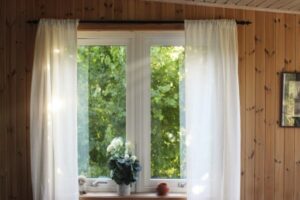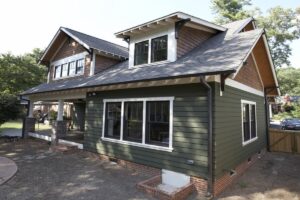Fiber cement vs vinyl vs wood? How do you choose?
The siding on your home is so much more than a pretty facade. It’s your home’s first defense barrier against weather, heat, and cold. When choosing the best siding for your home, you need to consider the climate, your budget, and the aesthetic you want.
Let’s look at the pros and cons of fiber cement, wood, and vinyl.
Vinyl Siding
Pros
Vinyl is a popular siding option for those on a budget. It’s cheaper than wood and fiber cement. Vinyl panels are light and easy to install, which can also cut down on installation and transport costs.
Vinyl comes in various styles and colors, offering many design options. It’s also a low-maintenance siding material that doesn’t need to be painted or resealed. Simply keep it clean with a hose.
Cons
Vinyl siding is prone to cracking and fading, especially in extreme weather conditions. Although vinyl is a cost-effective siding option in the short term, it has limited repair options. If your vinyl siding is damaged, you may have to replace it.
Wood Siding
Pros
Wood siding has a beautiful, natural aesthetic that many people love. Wood also has natural insulating properties, making it an energy-efficient siding option. Unlike vinyl, wood siding is easy to repair. You can repair or replace the damaged section without replacing all your siding.
Cons
Wood siding requires regular maintenance. You must be vigilant about inspecting your siding for rot, decay, and insect damage. To keep the wood siding looking good and performing well, it needs to be repainted, resealed, and stained regularly. This makes maintenance expensive.
Wood siding costs more than vinyl or fiber cement, especially the higher-end wood species. Another drawback of wood siding is the fire risk it poses.
Fiber Cement Siding
Pros
Fiber cement is our choice for Kentucky homes, and here’s why. It’s extremely durable. Fiber cement, like James Hardie siding, is made from cement, cellulose fibers, and sand. The combination of ingredients creates a new substance that can withstand harsh weather and not succumb to insect damage. Unlike vinyl and wood siding, fiber cement is non-combustible and has a high fire rating. This safety feature can also help lower your insurance premium.
Fiber cement siding is a painted product and holds paint well. James Hardie board comes pre-painted with ColorPlus Technology. Layers of color are baked on, making the siding extremely durable, vibrant, and resistant to fading.
Many people choose wood siding for its natural look, but fiber cement can mimic wood at a lower price and without maintenance issues. Fiber cement boards can also mimic stucco and masonry, perfect for creating personalized aesthetic or historical detail.
Cons
Although we recommend James Hardie, there are some things to consider when choosing fiber cement vs vinyl vs wood.
Fiber cement requires professional installation with a company familiar and confident with the material. Installation may cost more than wood or vinyl because the team requires specialized skills.
Fiber cement boards are also heavier than vinyl, increasing the installation and transport costs. Installing fiber cement siding is also more expensive upfront than vinyl, and you will need to repaint it after 15 years.
Fiber Cement vs Vinyl vs Wood
Vinyl is the cheapest, followed by fiber cement and wood for initial installation costs. But in the long run, fiber cement is the most cost-effective because it is durable, low maintenance, and increases the value of your home.
When it comes to energy efficiency, wood is the most insulating, but only if properly maintained. Fiber cement is more insulating than vinyl and requires much less work than wood siding to keep it that way.
Fiber cement lasts the longest at 30-50 years, while vinyl lasts 23-30 years. The lifespan of wood siding depends on maintenance, wood species, and the climate.
Which Siding Is Right For You: Fiber Cement vs Vinyl vs Wood
If you’re in Kentucky, we recommend James Hardie Siding. It’s durable, cost-effective, and gives you versatile design options.
If you want to learn more about fiber cement vs vinyl vs wood, contact us for a free consultation.






